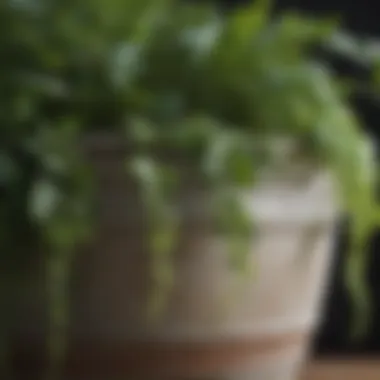Exploring the Aesthetic Benefits of Live Trailing Plants


Intro
Live trailing plants offer a unique and eye-catching element in both interior and exterior designs. They not only enhance the aesthetic appeal of a space but also contribute positively to air quality and the overall ambiance. With the rising trend of incorporating greenery into various environments, understanding their benefits and care requirements becomes essential. This article aims to provide in-depth insights, practical tips, and design inspirations, ensuring you make the most out of these vibrant plants.
Design Inspirations
Trending Styles
When it comes to decorating with trailing plants, several styles have gained popularity. From minimalistic setups to lush, bohemian vibes, these plants can adapt to any concept. Here are a few trending styles that incorporate live trailing plants:
- Minimalism: Select a few well-placed trailing plants such as Pothos or String of Hearts in simple containers for a clean look.
- Bohemian: Use diverse species like Tradescantia and Rhipsalis, along with macramé hangers to create a relaxed environment.
- Modern Industrial: Combine trailing plants with metal planters and exposed structures to achieve a contemporary feel.
Each style lends a unique character to the space, allowing homeowners to choose plants that suit their personal tastes and functional needs.
Color Palettes
Selecting the right color palette is just as crucial as the choice of plants. Trailing plants often bring vibrant greens but can also feature stunning variegation. Consider the following color combinations when styling:
- Earth Tones: Rich greens with rustic browns create a grounded look, ideal for cozy settings.
- Pastels: A blend of light greens, pinks, and creams fosters a light and airy atmosphere, perfect for minimalist spaces.
- Contrasting Colors: The dramatic effect of darker pots with bright foliage makes for an intriguing display, emphasizing the beauty of the plants more effectively.
These palettes not only guide the visual aspects but also influence the mood of the space.
Maintenance and Upkeep
Seasonal Maintenance Checklist
Proper care is fundamental to the longevity of trailing plants. Here’s a concise checklist to follow throughout the year:
- Spring: Check for new growth. Repot if necessary, and ensure adequate nutrients.
- Summer: Monitor watering frequency, increase checks for pests, and prune as needed.
- Autumn: Begin to reduce watering as growth slows. Clean foliage to remove dust.
- Winter: Keep plants away from drafts. Limit watering and focus on indoor lighting requirements.
By adhering to this checklist, you can ensure that your trailing plants remain healthy and vibrant.
Cleaning and Organization Tips
Maintaining cleanliness in your plant displays is vital for appearance and plant health. Here are some simple tips:
- Wipe Leaves: Regularly use a damp cloth to clean leaves. This promotes photosynthesis and reduces dust buildup.
- Organize Pots: Arrange pots to allow adequate space for growth but still create a visually appealing layout.
- Group Plants: Cluster plants with similar needs together. This facilitates easier maintenance and enhances aesthetics.
Taking these steps can improve the overall look of a space, making it more enjoyable for both residents and guests.
"Live trailing plants can dramatically elevate your indoor and outdoor environments with their beauty and air-purifying abilities."
By focusing on these elements, homeowners can successfully incorporate live trailing plants into their spaces, benefiting from their aesthetic and health advantages.
Understanding Live Trailing Plants
Understanding live trailing plants is vital for anyone interested in enhancing their interior or exterior spaces. These plants not only add visual interest but also serve practical purposes in design. Live trailing plants feature elongated stems that gracefully cascade over containers or surfaces, creating a natural, organic aesthetic that can soften hard lines in a room or garden.
One significant characteristic of trailing plants is their adaptability. Many species thrive indoors, responding well to varying light conditions while adding lush greenery to home décor. Outdoors, they can complement landscapes, performing well in both containers and as ground cover. This versatility allows homeowners and designers to integrate them seamlessly into various design concepts.
Definition and Characteristics
Trailing plants, also known as cascading plants, are defined by their long, flexible stems that tend to grow downward. Common examples include Pothos and String of Hearts. These plants can grow in various environments, making them suitable for different settings, from living rooms to patios.
The primary characteristics of live trailing plants include:
- Growth Habit: Their tendency to grow over edges or hang down from containers.
- Leaf Structure: Often feature heart-shaped or elongated leaves, depending on the species.
- Light Preferences: Many can tolerate low light, although some thrive in bright conditions.
This knowledge is essential for choosing the right plant for your specific design vision. By understanding their growth habits and needs, you can effectively incorporate them into your design scheme.
The Role of Trailing Plants in Design
Trailing plants play a significant role in both interior and exterior design. They can soften the hard edges of furniture or landscapes, creating a harmonious balance within the space. Indoor, they can be used as a focal point on shelves, or as hanging plants from ceilings, contributing to vertical design. Outdoor, they add layers to garden borders, enhancing the overall appearance of the landscape.
Utilizing trailing plants can also aid in creating microclimates. Their foliage can provide shade and reduce temperature fluctuations around them, making them practical additions to gardens. Additionally, they improve visual interest and encourage a sense of wellness through greenery. In an age of urbanization, incorporating these plants is not just aesthetic but also beneficial for mental well-being.
Benefits of Live Trailing Plants
Live trailing plants offer numerous advantages that can enhance both indoor and outdoor spaces. Their growing popularity in design is not accidental; these plants contribute to improved air quality, aesthetic values, and efficient space utilization. Understanding these benefits can help homeowners and design enthusiasts incorporate trailing plants effectively into their environments.
Air Quality Improvement
One of the notable benefits of live trailing plants is their ability to improve air quality. Many varieties are known for their air-purifying properties. For example, Pothos and Spider Plants can filter toxic substances such as formaldehyde, benzene, and xylene from the air. This purification process occurs as the plants absorb these pollutants through their leaves. In this way, trailing plants play a role in creating healthier indoor environments.
Regularly incorporating these plants into homes or workplaces can lead to noticeable changes in air quality over time. Not only can live trailing plants improve the air we breathe, but they also contribute to overall well-being by reducing indoor air pollution levels.
Aesthetic Appeal


Live trailing plants also add significant aesthetic appeal to spaces. Their unique growth habits create dynamic visual interests. The cascading leaves bring a sense of movement and life to interior design. Unlike static decor, the flowing appearance of trailing plants can transform bland corners into vibrant focal points. Their varied colors and textures offer flexibility in styling, making them suitable for any design scheme.
Integrating these plants through hanging planters or vertical gardens can create striking displays, blending nature with modern design. The trend of biophilic design emphasizes the importance of nature in our living spaces, making trailing plants an ideal choice for enhancing aesthetic values in any environment.
Versatility in Space Utilization
Trailing plants are known for their versatility in space utilization. They can thrive in a variety of settings, from small apartments to vast gardens. Their growth habit allows for creative arrangements in limited spaces where traditional plants may not fit. For instance, utilizing wall-mounted planters or shelves allows homeowners to enjoy greenery without occupying too much floor space.
Furthermore, trailing plants can adapt to numerous environmental conditions, enabling their placement in diverse spots such as sunny balconies or shaded patios.
"Live trailing plants not only beautify spaces but also maximize available areas."
This versatility extends beyond their physical placement. They can be used in combinations with various decor elements to create unique and personal environments that reflect individual tastes.
In summary, the benefits of live trailing plants encompass air quality improvement, aesthetic enhancement, and versatility in space utilization. Each aspect reinforces the importance of these plants in both interior and exterior designs.
Popular Varieties of Live Trailing Plants
Live trailing plants are oftentimes chosen for their aesthetic appeal and adaptability. Their importance in interior and exterior design cannot be overstated. The right variety can transform a space, adding not only beauty but also texture and depth. Each trailing plant has unique characteristics, which makes understanding these varieties essential for the successful integration into your environment.
Pothos
Pothos, scientifically known as Epipremnum aureum, is a standout when it comes to trailing plants. This variety is valued for its vibrant green leaves, which can also come in variegated patterns. Pothos is particularly hardy, making it suitable for both beginners and seasoned gardeners.
Care Considerations:
- Light: Pothos thrives in bright, indirect light but can also adapt to lower light conditions.
- Watering: It prefers to dry out between watering, making it less demanding.
- Growth: This plant can grow quite rapidly, so regular pruning is necessary to maintain its shape and fullness.
Pothos is an excellent option for creating lush, green landscapes, whether in hanging baskets or trained along shelves.
String of Hearts
The Ceropegia woodii, or String of Hearts, is another attractive choice. This plant features delicate, heart-shaped leaves that dangle gracefully. Its trailing vines can reach impressive lengths, making it perfect for hanging arrangements.
Benefits:
- Unique Aesthetic: The subtle color and shape of its leaves create a delicate appearance, admired in various design schemes.
- Drought Tolerance: String of Hearts can withstand less frequent watering, making it ideal for those who may forget regular plant care.
This plant's charming look is well-suited to modern decor styles that favor minimalism and natural elements.
Spider Plant
Spider Plant, or Chlorophytum comosum, is a beloved choice for many homeowners. Known for its arching leaves and baby plantlets, it adds a vibrant, lively aspect to interior spaces.
Care Tips:
- Light: It prefers bright, indirect sunlight but can tolerate low light.
- Watering: Allow the soil to dry slightly before watering again.
- Propagation: Spider Plants are easy to propagate via their plantlets, making them ideal for sharing with friends.
Adding Spider Plants to a home not just enhances air quality but it also serves as a conversation starter.
Trailing Jade Plant
The Trailing Jade Plant, known scientifically as Crassula perfoliata Falcata, is a succulent with a unique look. Its thick leaves form a cascading effect, giving it a distinct style compared to other trailing plants.
Considerations:
- Light: Adequate sunlight will promote healthy growth.
- Watering: This plant needs infrequent watering. Over-watering can lead to root rot.
- Soil: A well-draining soil mix is crucial for its health.
This plant exhibits an exotic aesthetic that can fit into both contemporary and rustic environments.
Incorporating these varieties into your design scheme can elevate your spaces in diverse ways. Whether you seek drama or subtlety, each of these trailing plants offers something distinctive and visually appealing.
Care Requirements for Trailing Plants
Understanding the care requirements for trailing plants is essential for both novice and experienced gardeners. These plants offer beauty and versatility in design but require specific conditions to thrive. Focusing on these elements helps in sustaining their growth and ensuring they remain a striking feature in any space.
Light Needs
The amount of light trailing plants receive significantly influences their overall health. Most trailing plants prefer bright, indirect light. Direct sunlight can scorch their leaves, while too little light may lead to stunted growth.
- Pothos does well in low to moderate light.
- String of Hearts thrives in bright, indirect light and can tolerate some direct morning light.
- Spider Plants are adaptable and can tolerate low-light conditions, which makes them suitable for various interiors.
It's wise to consider the placement of these plants. For example, hanging planters near east-facing windows work well as they get gentle morning sun. Adjustments may be necessary depending on the varying seasons and light intensity.
Watering Guidelines
Watering is another critical factor in the care of trailing plants. Overwatering is a common pitfall, leading to root rot and other issues. Knowing when and how much to water can greatly enhance plant health.


- Most trailing plants prefer their soil to dry out slightly between waterings. A simple finger test can help determine this.
- General watering frequency:
- Weekly in spring and summer.
- Less frequent in fall and winter.
Ensure good drainage to avoid stagnant water. Containers with drainage holes are highly recommended. Additionally, the quality of water can matter; using distilled or rainwater can enhance plant vitality.
Soil and Fertilization
Soil quality is crucial for the growth of trailing plants. A well-draining potting mix can support root health and provide the necessary nutrients. Many gardeners choose a mix designed for succulent plants or cacti, as these often have excellent drainage properties.
- Fertilization:
- During the growing season, a balanced liquid fertilizer can be applied monthly. This provides the nutrients trailing plants need to flourish.
- Reducing or ceasing fertilization during the dormant months is advisable to prevent nutrient build-up.
Watch out for signs of nutrient deficiency: yellowing leaves or slow growth can indicate a need for fertilizers.
Pruning and Maintenance Tips
Proper pruning enhances the aesthetic appeal and health of trailing plants. Regular maintenance encourages fuller growth and prevents them from becoming leggy.
- Trim back excessive growth at least once a year to maintain shape.
- Remove dead or yellowing leaves to promote fresh growth.
- Pinching tips during the growing season can encourage bushier growth as well.
These plants also benefit from occasional checking for pests. Regularly inspecting the foliage can prevent infestations from becoming serious issues.
Keeping a consistent care routine for trailing plants not only ensures their health but also enhances their beauty within your space.
By understanding and implementing the above care requirements, one can enjoy the numerous benefits that trailing plants bring to both interior and exterior designs.
Incorporating Live Trailing Plants in Interior Design
Incorporating live trailing plants in interior design has gained traction due to their unique ability to enhance the ambiance of a space. These plants not only serve aesthetic functions but can also create a calming atmosphere. Their gentle, flowing shapes provide visual relief, making them suitable for various styles of decor, from modern minimalism to bohemian chic. Using trailing plants thoughtfully can help soften the lines of furniture, balance color palettes, and even improve indoor air quality.
Creating Vertical Gardens
Vertical gardens are an innovative way to maximize space and incorporate greenery in interior design. This approach can transform an empty wall into a lush landscape. Select appropriate trailing plants like Pothos or String of Hearts that can comfortably climb or cascade downwards. When setting up a vertical garden, consider the following key aspects:
- Light Exposure: Ensure that the plants chosen can thrive in the light conditions of the wall you want to enhance.
- Support Structures: Use trellises or wall-mounted planters to support the growth of the plants.
- Soil and Water: Choose a suitable potting mix and establish a watering schedule that accommodates both the plants and installation setup.
Creating a vertical garden not only adds beauty to your space but also contributes to better air quality. \n
Green Shelving Ideas
Green shelving is another effective method to bring in trailing plants. Bookshelves or decorative shelves can house various plants, creating a harmonious blend of nature and design. Consider the following pointers when styling green shelving:
- Layering: Use different shelf heights to create visual interest. Position taller plants at the back and smaller ones at the front.
- Incorporation of Planters: Choose planters that match the shelf style. Terracotta pots or ceramic containers can elevate the overall effect.
- Balance: While adding plants, ensure that the shelf does not become overcrowded. Leave visible space for books or decorative items.
Adding trailing plants to shelving can create a serene environment and allow personal expression through plant choice and arrangement.
Styling with Hanging Planters
Hanging planters are an excellent way to incorporate live trailing plants without taking up valuable surface area. This option brings versatility, allowing plants like the Spider Plant or Trailing Jade Plant to drape elegantly from above. When styling with hanging planters, keep these points in mind:
- Placement Height: Hang planters at varying heights to create depth. Ensure they are accessible for maintenance and watering.
- Material Choice: Select planters that complement your interior decor. This could be macramé hangers, metal, or natural materials.
- Synergy with Room Aesthetics: Choose plants that match your room’s color scheme or theme, adding a cohesive feel.
Hanging planters draw attention upward in a room, creating a feeling of spaciousness while also serving as a living piece of art.
Incorporating trailing plants into your interior design can significantly enhance the visual appeal and functionality of your space.
By understanding and implementing these methods, homeowners can effectively integrate live trailing plants into their living spaces, enriching the environment with beauty and fresh air.
Designing Outdoor Spaces with Trailing Plants
Creating inviting and functional outdoor spaces is a key aspect of home design. Using live trailing plants can transform areas like patios, balconies, and gardens. These plants offer aesthetic value, natural beauty, and environmental benefits. Incorporating trailing plants can also enhance the microclimate around living spaces, providing cooler temperatures and improved air quality.
Patios and Balconies
Patios and balconies serve as extensions of our living spaces, making them prime candidates for incorporating trailing plants. These areas usually have limited ground space but can be elevated by vertical greenery. Hanging planters filled with beloved varieties, such as Pothos or String of Hearts, can cascade beautifully over edges. This creates an inviting atmosphere for relaxation or entertaining.
Consider using trellises or vertical planters to maximize the use of space. These options allow trailing plants to climb and drape, adding depth. Maintenance is crucial here. Regular watering, monitoring for pests, and periodic pruning will enhance the appearance of these plants and help them thrive.
Garden Borders and Borders
Garden borders benefit significantly from trailing plants. Their ability to spill over walkways or onto adjacent structures creates a seamless and lush transition between different areas of the garden. Selection of the right species is vital. For hardier borders, Spider Plant or Trailing Jade Plant can provide an appealing contrast with structured plants.
When designing borders, it’s important to assess sunlight exposure and moisture levels. A mix of trailing and upright plants can yield vibrant variations in height and spread, contributing to visual interest. Integrating these plants also encourages biodiversity, offering habitat for beneficial insects.
Foundation Planting


Using trailing plants in foundation planting is an excellent way to soften building lines and enhance curb appeal. Proper selection is key. Plants like English Ivy or Creeping Thyme cascade nicely down the foundation, masking potentially unattractive areas of homes.
When planning foundation plants, the growing conditions should be taken into account—considering factors such as shade, moisture, and soil composition. Trailing plants can provide a natural frame and can be used in conjunction with other landscaping elements to create a cohesive design.
Incorporating trailing plants into outdoor spaces not only enhances beauty but also supports ecological health.
Propagation Techniques for Trailing Plants
Propagation is crucial when working with live trailing plants. It allows enthusiasts to expand their collection, create new arrangements, or share plants with others. Understanding and employing the right propagation techniques enhances the growth and longevity of these plants. In this section, we will discuss various methods, including the cuttings method, dividing established plants, and water propagation. Each method has its benefits and considerations that cater to different situations, making it essential to choose wisely based on the specific plant and environment.
Cuttings Method
The cuttings method is one of the most common and effective techniques for propagating trailing plants. This method involves taking a healthy stem segment from the parent plant and encouraging it to root in a suitable medium. Here’s how it works:
- Select a healthy stem: Look for a robust stem with several leaves. Ensure that it is free from pests or diseases.
- Make the cut: Use sterilized scissors or pruning shears to take a cutting that is about 4-6 inches long. Cut just below a leaf node for the best results.
- Remove lower leaves: Trim any leaves from the bottom half of the cutting to prevent rot when placed in soil or water.
- Rooting medium: Place the cutting in either moist soil or a glass of water. If using soil, ensure it is well-draining.
- Provide warmth and humidity: Cover the cutting with a plastic bag or place it in a greenhouse to maintain humidity while it roots.
- Monitor growth: After a few weeks, roots should develop, indicating it’s ready to be potted.
This method is favored for its simplicity and the speed at which cuttings can establish roots. Many enthusiasts find success with species like Pothos and Spider Plants through this technique.
Dividing Established Plants
Dividing established plants is another effective method of propagation. This approach is best when the plant has outgrown its pot or has several stems. Here’s how to do it:
- Choose an older plant: Select a healthy, mature plant that has multiple stems or offshoots.
- Remove the plant from the pot: Gently pull it out and shake off excess soil. Be careful not to damage roots.
- Identify sections: Look for natural divisions in the root ball where the stems meet the roots.
- Divide carefully: Use a sharp, clean knife to slice through the root ball, ensuring that each section has roots and stems.
- Repot the divisions: Plant each divided section in new pots with fresh soil. Water lightly to settle the soil around the roots.
Dividing plants not only propagates them but also improves their health by preventing overcrowding. This method works well for plants like the Trailing Jade Plant and can rejuvenate older specimens.
Water Propagation
Water propagation is a visually appealing method that allows one to observe the root development. This technique is typically used for cuttings but can also be beneficial for certain plants. Here’s how:
- Select a cutting: Similar to the cuttings method, take a healthy stem cutting.
- Submerge in water: Place the cutting in a clear glass or jar, ensuring that at least a node is submerged in water.
- Change water regularly: It's essential to change the water every few days to keep it fresh and prevent the growth of bacteria.
- Wait for roots: Within a few weeks, tiny roots will start to develop, usually around 2-4 inches long. Once sufficient roots are present, the cutting can be transferred to soil.
Water propagation is not just functional; it also adds an aesthetic element to the process, allowing one to watch the roots grow. This technique is popular among those who enjoy monitoring plant growth closely.
Propagation techniques are essential not only for expanding your plant collection but also for maintaining the overall health of your plants.
By mastering these propagation techniques, you can ensure a flourishing collection of trailing plants, enriching your indoor and outdoor spaces alike. Each method suits different types of plants and personal preferences, so experimenting may yield the best results.
Challenges in Growing Live Trailing Plants
Growing live trailing plants may seem easy, but several challenges require attention. Identifying and managing these issues ensures thriving plants for both interior and exterior spaces. Understanding these obstacles is essential not just for the health of the plants, but also for achieving the desired aesthetic in your design.
Pest Management
Pest infestations are a key concern for anyone cultivating trailing plants. Common pests affecting these plants include aphids, mealybugs, and spider mites. These pests can weaken the plants by sucking sap, leading to stunted growth and unsightly damage. Effective pest management requires vigilance.
- Regular Inspection: Check plants frequently for early signs of pests. Infestations are easier to control when caught early.
- Natural Remedies: Insecticidal soaps and neem oil are effective treatments. They minimize harm to beneficial insects while targeting the pests.
- Cultural Practices: Maintain good air circulation and avoid overcrowding to deter pest proliferation.
Common Diseases
Trailing plants, like any other greenery, are susceptible to various diseases. Fungal infections, such as powdery mildew or root rot, can devastate plant health. Monitoring water levels and humidity is crucial.
- Symptoms: Yellowing leaves, wilting, or unusual spots can indicate disease. Address these issues promptly.
- Prevention: Ensure appropriate watering practices. Overwatering is often a leading cause of root rot. Allowing soil to dry out between rounds of watering can mitigate this risk.
- Sanitation: Clean pots and tools regularly to avoid transferring pathogens between plants.
Environmental Stress Factors
Environmental stress plays a significant role in the health of trailing plants. Factors such as inadequate light, fluctuations in temperature, or improper humidity levels can stunt growth or lead to plant death.
- Light Requirements: Each plant species has different light needs. Familiarize yourself with these requirements and adjust their placement accordingly.
- Temperature Control: Protect plants from extreme temperatures. Both cold drafts and excessive heat can trigger stress responses.
- Humidity Levels: Many trailing plants thrive in higher humidity. Using a humidifier or placing water trays nearby can help create comfortable conditions for them.
Tip: Always tailor your care routine to the specific needs of your plants. This can help prevent many common issues and keep your trailing plants healthy and vibrant.
Addressing these challenges allows for a successful gardening experience, making it possible to fully enjoy the benefits of live trailing plants in your home or garden.
End
The conclusion of this article serves to underscore the significance of live trailing plants in both interior and exterior design. The discussion reflects on the myriad benefits that these plants offer, from enhancing air quality to contributing aesthetically to various spaces. When selecting plants such as Pothos or String of Hearts, homeowners can create visually appealing environments that are also conducive to health.
The versatility of trailing plants makes them suitable for any setting. Whether you are designing a cozy nook in your living room or creating a vibrant garden border, these plants adapt to different conditions and styles. This adaptability is crucial, as it encourages creativity and personalization in space design. Furthermore, incorporating these plants promotes a deeper connection with nature, which can be beneficial for mental well-being.
Recap of Key Points
To summarize, here are the main aspects discussed:
- Definition and Characteristics: Understanding the unique features of trailing plants.
- Benefits: Highlighting improvements in air quality, aesthetic appeal, and space utilization.
- Care Requirements: Essential needs pertaining to light, water, and soil.
- Incorporation: Practical styling ideas for both interiors and outdoors.
- Propagation Techniques: Simple ways to grow more plants from existing ones.
- Challenges: Awareness of pests, diseases, and environmental factors.
Each of these points contributes to understanding how to effectively include live trailing plants in various designs, making spaces more inviting and healthier.
Encouragement for Incorporation
It is encouraged to think creatively about including live trailing plants in personal and professional spaces. As the article illustrates, their aesthetic qualities and health benefits provide a compelling reason to incorporate them. Consider experimenting with different varieties and placement options to find what works best for your environment.
By integrating these plants, you contribute positively to the overall ambiance of your space. Those engaged in interior design, gardening, or simply enhancing their living areas should take heed of the insights shared here. The successful incorporation of trailing plants can lead to improved functionality as well as enriched aesthetic experience. Embrace the possibilities that live trailing plants offer and enhance your living or working areas significantly.







